Welcome back.
Let’s do a roundup of what the situation looks like 128 days into Vladimir Putin’s 72-hour Special Military Operation against Ukraine.
Strategic Level
Major takeaways from the NATO Summit.
NATO member states have agreed to begin providing Ukraine with offensive weapons. This is a huge departure from the status quo. When NATO agreed to send HIMARS and MLRS to Ukraine, they also agreed to equip them with rockets that couldn’t directly threaten Russian population centers. My guess is that the physical manifestation of the promise of offensive weapons will be several hundred German Leopard 2A4 tanks currently in storage. They are obsolescent by the standard of the Abrams, Leopard 2A7, and Challenger 2, but they will be competitive with the Russian tanks that crossed the frontier in February and superior to the T-62s beginning to appear as replacement tanks in Russian units. We can surmise that transferring to Ukraine the upgraded MiG and Sukhoi fighters that gave everyone the vapors back in March-April is not far behind.
NATO/EU is working to establish transit routes for Ukrainian grain via Poland to avoid Russia’s blockade in the Black Sea. This will not be a quick process, but, like Western Europe seeking out new oil and gas supplies, it could be permanent.
The big news, of course, is that Sweden and Finland will join NATO–there is a rumor that Bulgarian might object because it gets 70+% of its natural gas from Russia. That would be a high-risk move for the Bulgarian government should it decide to do so.
Joe Biden, the UK’s Johnson, France’s Macron, and Germany’s Scholz have all said: 1) the war is going to be long, 2) it is vital that Russia not gain territory from the war, and 3) they will do what it takes to ensure Ukraine retains he capability to liberate its territory from the invading Russians. Talk is one thing; convincing economically challenged voters to continue supporting a protracted war is something entirely different.
Talk of forcing Ukraine to accept a disadvantageous peace agreement is now the exclusive province of folks who, for whatever reason, have decided that Russia is the aggrieved party that must be mollified.
Both rhetoric and actions indicate the dominant perception within NATO/EU is that Russia is struggling and can be beaten.
Notably, the Russian government–this does not include members of the Russian Duma/Federal Assembly who can say stuff at least as exotic as anything Maxine Waters can come up with–has dialed back threats of nuclear Armageddon. Putin has threatened to give Belarus nuclear-capable missiles (just a note, these would be a weapon type that Russia agreed to give up when the INF treaty was signed). Belarus President Lukashenko has asked Russia for nuclear weapons. This needs to be monitored, but it doesn’t seem all that probable. I’m sure that Putin and Lukashenko would not like Poland to get nuclear-capable missiles.
Operational Level
It’s always good to remind ourselves of the situation on the ground. This is the video of the first 90 days of the war.
Despite a lot of breathless reporting, that situation is largely unchanged. This map, courtesy of the Institute for the Study of War, shows the front line remains static. There are changes; we’ll hit the Russian operation in Donbas in a moment, but not significant changes.

New weapons in action
The US authorized the transfer of truck-based Harpoon missiles to Ukraine. They have been credited with sinking the sea-going tug Vasily Bekh.
Better video, clearly shows the Russian tug being hit by two Ukrainian antiship cruise missiles https://t.co/spvmBlfFzK pic.twitter.com/wJni7UsgNy
— OSINTtechnical (@Osinttechnical) June 17, 2022
HIMARS makes its debut.
Clear difference betweeen MLRS Grad/Uaragan and American HIMARS pic.twitter.com/IvQRaDevNj
— Giorgi Revishvili (@revishvilig) June 24, 2022
Ukraine is getting a major infusion of top-of-the-line NATO tube artillery along with rocket artillery. The German Panzerhaubitze 2000, French CAESAR, US M-109 and M777, and the Polish Krab are only some of the systems being deployed. Maintenance of a polyglot grouping of weapons can be a challenge for anyone. I suspect that higher echelon maintenance is being performed by foreign civilian contractors hired via the billions of dollars flooding into the war.
Several hundred Ukrainians have been trained to use the new artillery in Germany and the UK; more are being taught.
First prisoners from Mariupol have been exchanged.
When the city of Mariupol fell in May, some 1,700 Ukrainian soldiers passed into Russian custody. Most of those were members of the Azov battalion that the Russians and their fellow travelers derided as “Nazis.” The negotiated surrender agreement said they would be exchanged. The first of these are now back in Ukraine.
144 Ukrainian POWs returned today in a prisoner exchange with Russia. https://t.co/t3PJIQYm22 pic.twitter.com/HIIJBWwPfW
— OSINTtechnical (@Osinttechnical) June 29, 2022
Terror is now a weapon.
A week ago, a shopping mall in Kremenchuk was struck by a Russian cruise missile. Thursday an apartment block in Odesa was demolished. The fact that cruise missiles were used suggests that the intended targets were hit.
Kremenchuk.
Missile strike by Russian missiles on the shopping center.
Zelensky: It is impossible to imagine the number of victims.If this is not a terrorist attack, then what!? If Russia is not a terrorist country, then who are they? pic.twitter.com/jWhQdtSkSB
— Roman Hryshchuk (@grishchukroma) June 27, 2022
This is the moment a Russian missile struck a shopping mall in Kremenchuk, Ukraine, on Monday. Ukrainian security services released the footage from various angles of the property, where at least 20 people were killed during the strike. https://t.co/SYcWWersoa pic.twitter.com/ViGPLNuXTW
— CBS News (@CBSNews) June 30, 2022
As of 10:00, the death toll of the Russian missile attack on Odesa's Serhiivka was 18, 38 civilians were injured and hospitalized, 8 people were rescued from the rubble by Emergency Service workers.https://t.co/Rk4bg6wBKDhttps://t.co/gbjaYHAD2g pic.twitter.com/hHFdtebTFD
— Euromaidan Press (@EuromaidanPress) July 1, 2022
This is not a one-off. Several times each week, civilian targets, remote from the front and from military facilities, are hit by Russian missiles. It seems pretty clear that terror has become one of Russia’s standard tactics.
Russian generals continue to be fired.
The turmoil continues in the Russian chain of command in Ukraine.
Putin fired five Russian generals from the military's top brass this week amid Moscow's stumbling invasion of #Ukraine. https://t.co/UWaiCiJDak
— Viktor Kovalenko (@MrKovalenko) June 4, 2022
It is hard to determine what is going on without knowing the context. Is this a “give me results, now!” situation? Or are the patently incompetent and politically connected generals being weeded out? Is this the German Army in 1945? Or the American Army after Kasserine? I have my opinion, but it is just that.
Thrown into this mix is the arrival of HIMARS. This highly mobile multiple rocket launch system gives the Ukrainians the ability to target headquarters out of range of tube artillery. The current high mortality rate of senior Russian officers is because of the peculiarities of that army’s organization, like using generals as squad leaders, and attacks on headquarters facilities.
Ukrainian prisoners sentenced to death by a Donetsk court.
Ukraine has as many as 30,000 foreign volunteers in the ranks of its Territorial Defence Forces, a branch of the Ukrainian military. They have all taken an oath and met the requirements of the UN Convention on the use of mercenaries. These fighters are some of the most skilled in the Ukrainian Army. Two Britons and a Moroccan were captured. Russia has no death penalty, so they were turned over to a Donetsk “Republic” kangaroo court.
Video of the sentencing, confirming that one of #Russia's puppet republics in eastern #Ukraine, the "Donetsk People's Republic", has sentenced three foreign volunteers to death: Sean Pinner, Aiden Aslin (both British), and Saadoun Brahim (Moroccan ) pic.twitter.com/LEjkIpDxIk
— Kyle Orton (@KyleWOrton) June 9, 2022
Two Americans have been captured, and the same fate probably awaits them.
The Kremlin has suggested that the two men could face execution.https://t.co/CWAvLzKRyy
— Radio Free Europe/Radio Liberty (@RFERL) June 21, 2022
Snake Island
The arrival of modern artillery and Harpoon anti-ship missiles has made Snake Island untenable. Today, the Russians announced they had abandoned the island as a “goodwill gesture” to open a shipping lane for Ukrainian grain. Why Snake Island would have to be abandoned to accomplish this–not shooting at civilian ships would achieve the same purpose–is anyone’s guess.
The russian ministry of defence explained the withdrawal of troops from the Snake Island as a 'good will gesture'.
Ladies and gentlemen, this is how a good will gesture looks like: pic.twitter.com/uRxqrGAciZ
— Anton Shvets (@ShvetsAntonAnd) June 30, 2022
As I pointed out in an earlier post on the subject, anti-ship missiles on Snake Island, assuming they are deployed in tandem with credible air defense systems, puts Ukraine’s remaining Black Sea frontage, particularly Odesa and the Danube estuary, off-limits to the Russian navy.
Kherson
There has been significant activity on the southern front. As the maps show, the Ukrainian Army is making small and steady gains. Again the map is courtesy of the Institute for the Study of War.
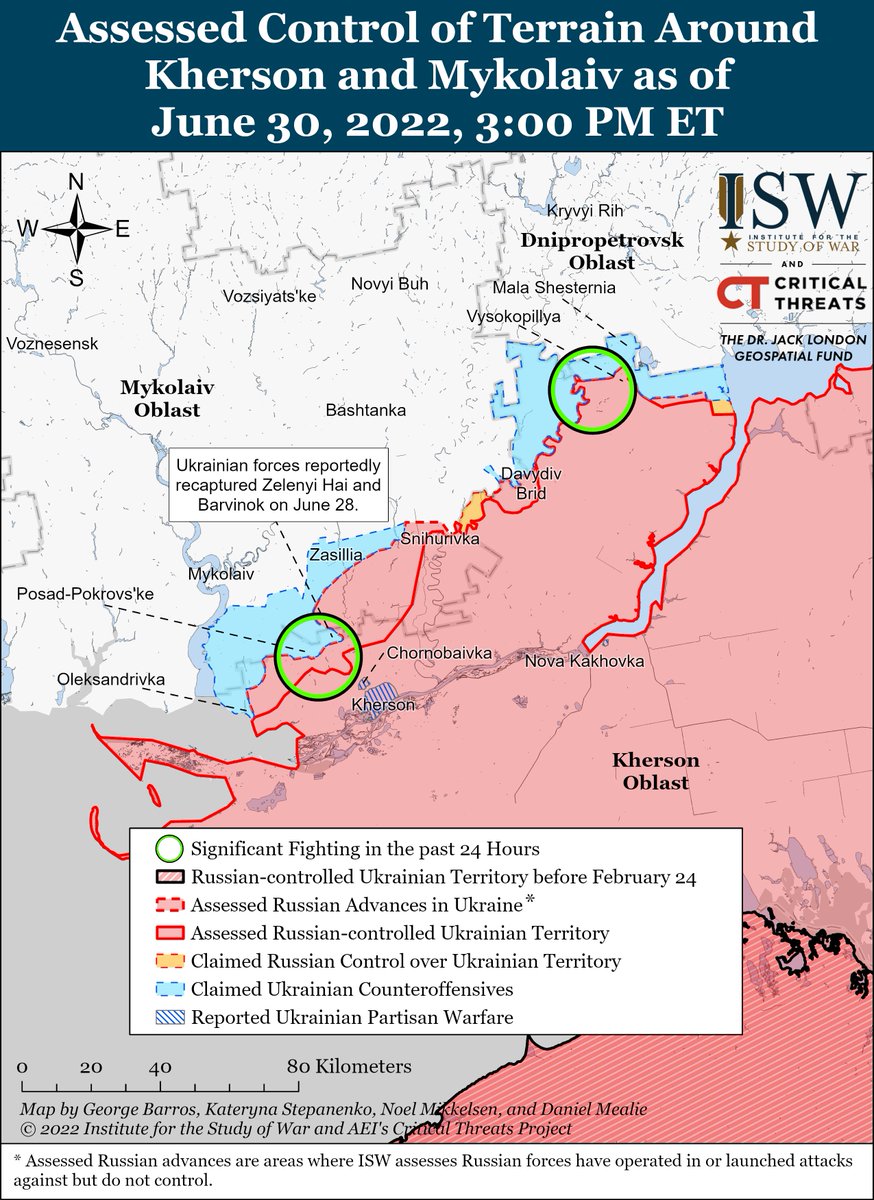
The Ukrainians are now less than 6 miles from Kherson City. Inside Kherson City, assassinations of collaborators and killings of off-duty Russian soldiers have become common. I doubt Ukraine will attempt to assault the city because that is a manpower-intensive and high-casualty operation. Instead, I would look for a Ukrainian offensive somewhere to the north aimed at the line of communication between Kherson and Melitopol. The obvious objective is Nova Kharkova which sits astride that critical line of communication and controls the aqueduct that supplies Crimea with most of its potable water.
Kharkiv
Kharkiv is basically static. Both sides make small gains, but none seem to be sustainable. Ukraine’s primary objective here is to push Russian artillery out of range of Kharkiv and to bleed off forces that could be used in Donetsk to defend this area in an economy of force operation.
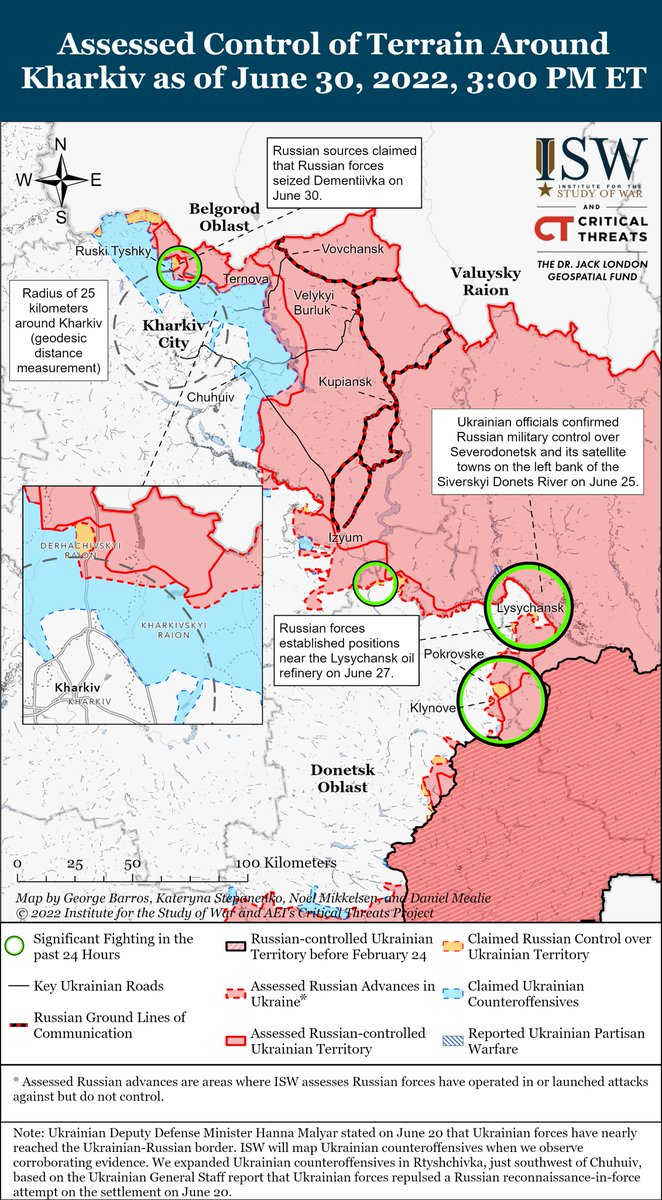
My prediction is that this will remain a backwater.
Donetsk
This theater of operations has gotten the most coverage because it is the only one where the Russians are having some success. The media needs a horserace narrative for their stories and this theater fits the bill. The Putin fans want to point to it as a sign of Russia’s inevitable victory. So let’s look at how the front lines have changed in Donetsk over the last 60 days. The animation is courtesy of the Australian Strategic Policy Institute.
After some high-profile disasters, the Russians seem to have moved to dismounted operations supported by massive artillery strikes. The Ukrainians have fought a dogged defense, but they are trading terrain for force preservation. Australian General Mick Ryan’s take is, I think, the correct one.
Sometimes, the Ukrainians will have to temporarily give up territory to win this war. While losing territory is bad for a country at war; losing your army is fatal. The Ukrainians have had a tough week. But it is not the same as them losing the war. https://t.co/hdErZbs2rp
— Mick Ryan, AM (@WarintheFuture) June 30, 2022
There is no doubt casualties have been high on both sides. The Ukrainians do not seem to have the combat power to stop the Russian advance, and the Russians don’t have the logistics system to support a rapid offensive or the troops to execute it. This is not an existential battle for either side…unless one side or the other breaks. Is the Russian advance akin to Rommel’s panzers in France in 1940? Or is it the Battle of the Bulge?
Prognosis
This war is at a stalemate for the moment. I haven’t written about the war because I haven’t seen much change in the underlying dynamics. Making predictions based on daily combat operations is like political analysts who make new predictions based on each poll.
The real struggle goes on out of sight. The Ukrainians declared conscription in March. Under a compressed training schedule, those units formed early should be making their appearance soon. The Russians are also having manpower issues. The daily bulletin by the UK Defence Ministry says that desertions and combat refusals have become common in the Russian Army. Those reports are, as far as I can tell, based on intercepted phone calls. Allegedly, Russian veterans are being offered three-month contracts to fight in Ukraine. At this point, I’m skeptical of most of the reports.
To me, the critical factor is that more modern varieties of tanks, artillery, and armored vehicles are replacing Ukrainian equipment. The Russians are digging into war stocks and replacing modern equipment with obsolescent vehicles and guns. In a long war, this will be decisive.
I see no evidence that Ukraine is in danger of political, moral, or military collapse.
However, I see evidence that Russia is looking for an exit. I believe that Russia is focusing on Donetsk because it wants to occupy the geographical boundaries of Luhansk and Donetsk and call for a cease-fire to attempt to lock in their gains. If Ukraine wants to continue the war, that could possibly cause some political difficulties inside NATO/EU.
My best guess is that we’ll see more of this until about August, and then the new round will open with different armies than started the war.
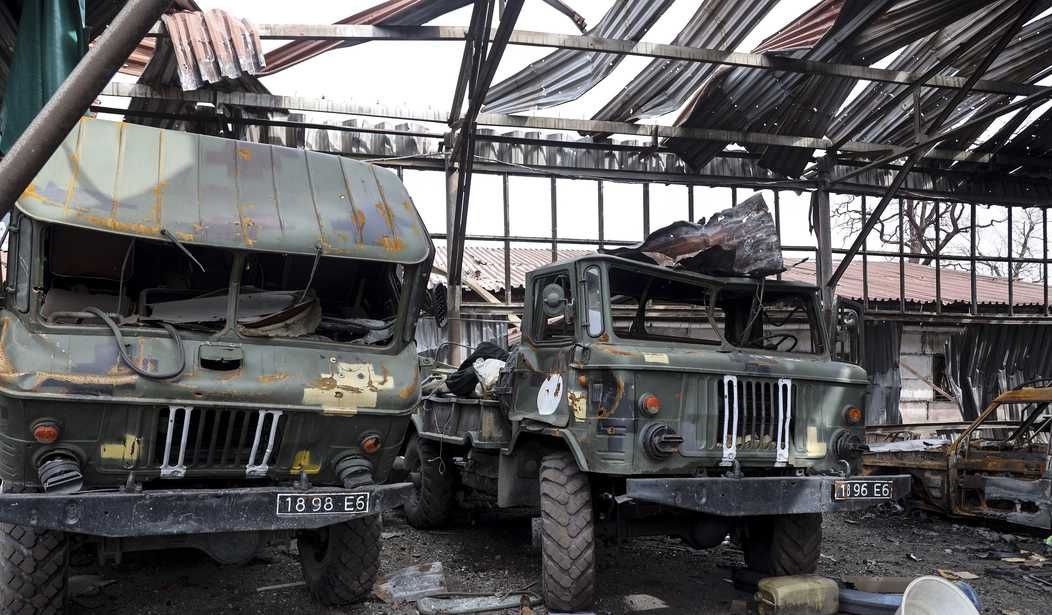





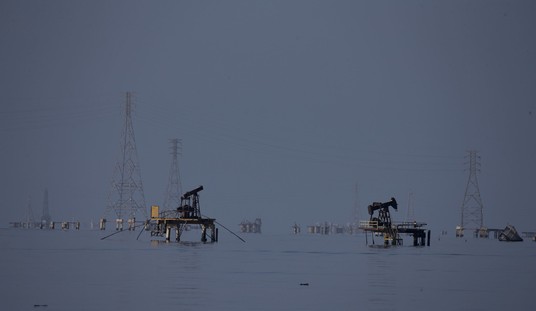




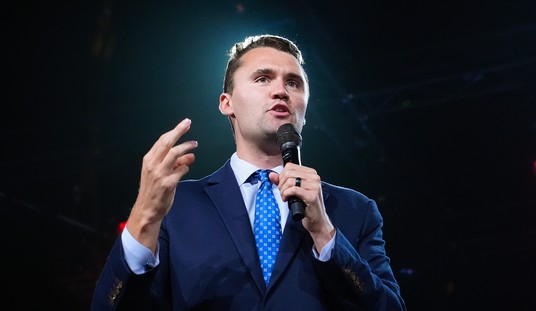
Join the conversation as a VIP Member